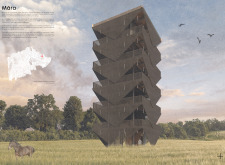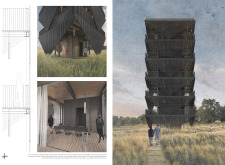5 key facts about this project
The Kurgi Observation Tower, named Māra after the Latvian earth goddess, is located within the North Vidzeme Biosphere. It serves as a space where visitors can reflect and connect with the surrounding natural environment. The design aims to create a minimal impact on the land while offering a distinctive way for people to engage with panoramic views of the landscape.
Design Concept
The structure features a cruciform layout that aligns with the main directions of the landscape. This shape helps in distributing wind loads effectively, allowing the tower to maintain a light presence without overwhelming its surroundings. With multiple entry points, including stairs and lifts, visitors are encouraged to explore various angles and experiences as they move upward through the structure.
Facade and Light
The tower's façade is made up of vertical slats inspired by the cultural symbol of Māra, which filters light into the interior. This design brings in natural illumination, changing the atmosphere inside throughout the day. The façade also protects users from the elements while allowing them to enjoy the beauty of the environment outside.
Upper Enclosure Strategies
At the top, the design provides flexibility through various enclosure options. The seating area can be closed off with mesh curtains and sliding translucent screens, providing shelter when needed. This adaptability allows the space to change in response to different weather conditions while ensuring a connection to the outdoors.
Material Selection
Steel is used for the structural components, while timber features prominently in the façade and flooring. This choice of materials supports maintenance and upholds sustainability principles, making it easier for the structure to be disassembled and reused in the future. The uniform height between floors supports a straightforward construction process and encourages efficiency throughout the build.
The upper areas offer wide views, giving visitors a chance to truly immerse themselves in the surrounding biosphere. This design choice invites reflection and encourages a deeper appreciation for the natural landscape.





















































